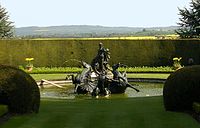
In the 19th century members of the English Rothschild family bought and built many country houses in the home counties, furnishing them with the art the family collected. The area of the Vale of Aylesbury, where many of the houses were situated, became known as "Rothchildshire". In the 20th century many of these properties were sold off with their art collections dispersed. Today only Eythrope House still belongs to the family; however, they still retain influence in how Ascott House and Waddesdon Manor are managed. In the loss of country houses in the 20th century only Aston Clinton was lost.

Ascott is a hamlet and country house in the parish of Wing, Buckinghamshire, England. The hamlet lies completely within the boundary of the Ascott Estate; it is home to many of the estate and house staff.

Waddesdon Manor is a country house in the village of Waddesdon, in Buckinghamshire, England. Owned by the National Trust and managed by the Rothschild Foundation, it is one of the National Trust's most visited properties, with over 463,000 visitors in 2019.

Waddesdon is a village in Buckinghamshire, England, 6 miles (10 km) west-north-west of Aylesbury on the A41 road. The village also includes the hamlets of Eythrope and Wormstone. Waddesdon was an agricultural settlement with milling, silk weaving and lace making enterprises.

Eythrope is a hamlet and country house in the parish of Waddesdon, in Buckinghamshire, England. It is located to the south east of the main village of Waddesdon. It was bought in the 1870s by a branch of the Rothschild family, and belongs to them to this day.

Mentmore is a village and civil parish in the Aylesbury Vale district of Buckinghamshire, England. It is about three miles east of Wingrave, three miles south east of Wing.

Mentmore Towers, historically known simply as "Mentmore", is a 19th-century English country house built between 1852 and 1854 for the Rothschild family in the village of Mentmore in Buckinghamshire. Sir Joseph Paxton and his son-in-law, George Henry Stokes, designed the building in the 19th-century revival of late 16th and early 17th-century Elizabethan and Jacobean styles called Jacobethan. The house was designed for the banker and collector of fine art Baron Mayer de Rothschild as a country home, and as a display case for his collection of fine art. The mansion has been described as one of the greatest houses of the Victorian era. Mentmore was inherited by Hannah Primrose, Countess of Rosebery, née Rothschild, and owned by her descendants, the Earls of Rosebery.

Wingrave is a village in Buckinghamshire, England, about four miles northeast of Aylesbury and three miles southwest of Wing.

Halton House is a country house in the Chiltern Hills above the village of Halton in Buckinghamshire, England. It was built for Alfred Freiherr de Rothschild between 1880 and 1883. It is used as the main officers' mess for RAF Halton and is listed Grade II* on the National Heritage List for England.

Baron Mayer Amschel de Rothschild was an English businessman and politician of the English branch of the Rothschild family. He was the fourth and youngest son of Hannah (Barent-Cohen) and Nathan Mayer Rothschild (1777–1836). He was named Mayer Amschel Rothschild, for his grandfather, the patriarch of the Rothschild family.
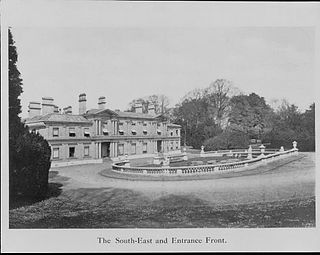
Aston Clinton House was a large mansion to the south-east of the village of Aston Clinton in Buckinghamshire, England.
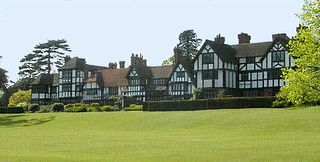
George Devey was an English architect notable for his work on country houses and their estates, especially those belonging to the Rothschild family. The second son of Frederick and Ann Devey, he was born and educated in London.

Baron Ferdinand de Rothschild, also known as Ferdinand James Anselm Freiherr von Rothschild, was a British banker, art collector and politician who was a member of the Rothschild family of bankers. He identified as a Liberal, later Liberal Unionist, and sat as a Member of Parliament in the House of Commons from 1885 to 1898. Ferdinand had a younger sister, Alice, who like her brother was a keen horticulturalist and collector. She inherited Ferdinand's property, Waddesdon Manor, in 1898 after he died and likewise continued the tradition of using the house as a place to keep his collections.
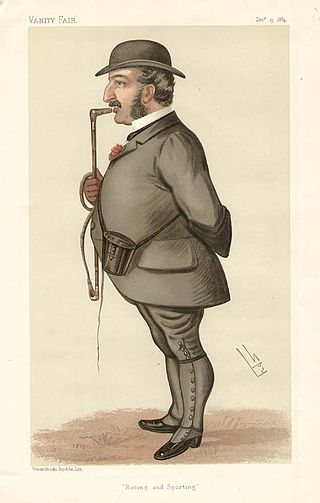
Leopold de Rothschild was a British banker, thoroughbred race horse breeder, and a member of the prominent Rothschild family.

Sir Henry Floyd Grammar School (SHFGS) is an 11–18 mixed sex, grammar school and sixth form with academy status in Aylesbury, Buckinghamshire, England. It is named after Sir Henry Floyd, a former Lord Lieutenant of Buckinghamshire. As a selective school, its entry requirements are governed by the exam taken by students entering Year 7.

Gunnersbury Park is a park between Acton, Brentford, Chiswick and Ealing, West London, England. Purchased for the nation from the Rothschild family, it was opened to the public by Neville Chamberlain, then Minister of Health, on 21 May 1926. The park is currently jointly managed by Hounslow and Ealing borough councils. A major restoration project funded by the Heritage Lottery Fund was completed in 2018. The park and garden is Grade II listed.

Buckinghamshire County Cricket Club is one of twenty minor county clubs within the domestic cricket structure of England and Wales. It represents the historic county of Buckinghamshire.
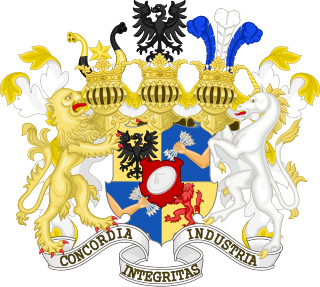
The Rothschild banking family of England is the British branch of the Rothschild family. It was founded in 1798 by Nathan Mayer Rothschild (1777–1836), who first settled in Manchester before moving to London, Kingdom of Great Britain. He was sent there from his home in Frankfurt by his father, Mayer Amschel Rothschild (1744–1812). Wanting his sons to succeed on their own and to expand the family business across Europe, Mayer Amschel Rothschild had his eldest son remain in Frankfurt, while his four other sons were sent to different European cities to establish a financial institution to invest in business and provide banking services. Nathan Mayer Rothschild, the third son, first established a textile jobbing business in Manchester and from there went on to establish N M Rothschild & Sons bank in London.
Anthony Gustav de Rothschild was a British banker and member of the Rothschild family.

The Rothschild family residences are palaces, castles and houses which are, or were, occupied by members of the Rothschild family in Europe.






